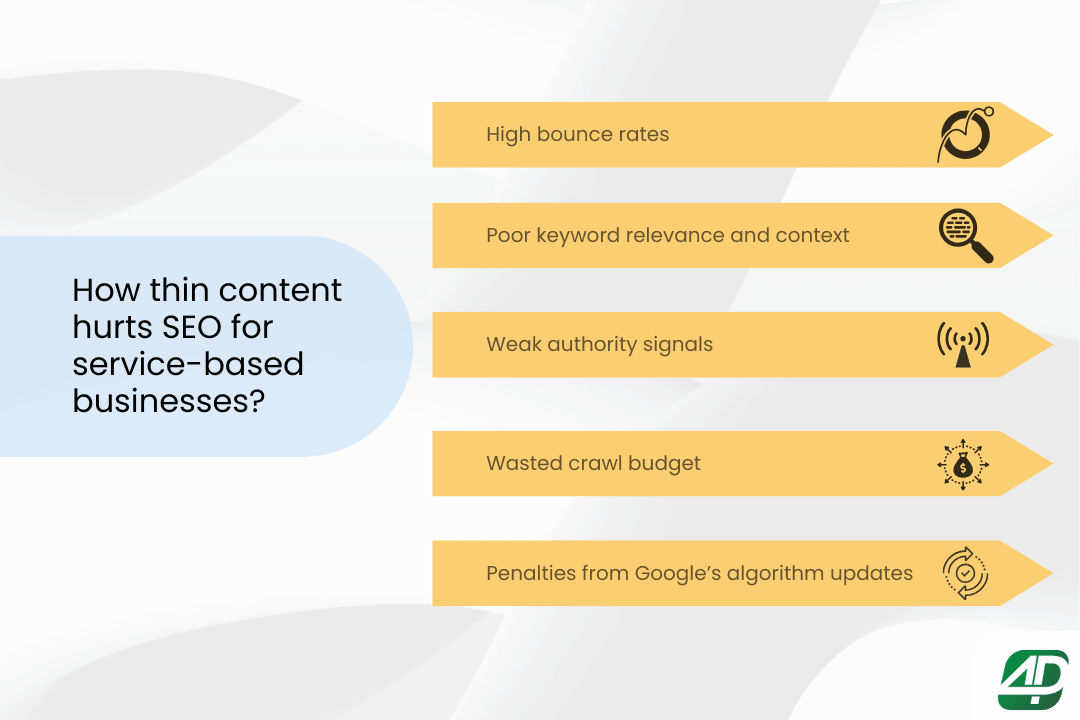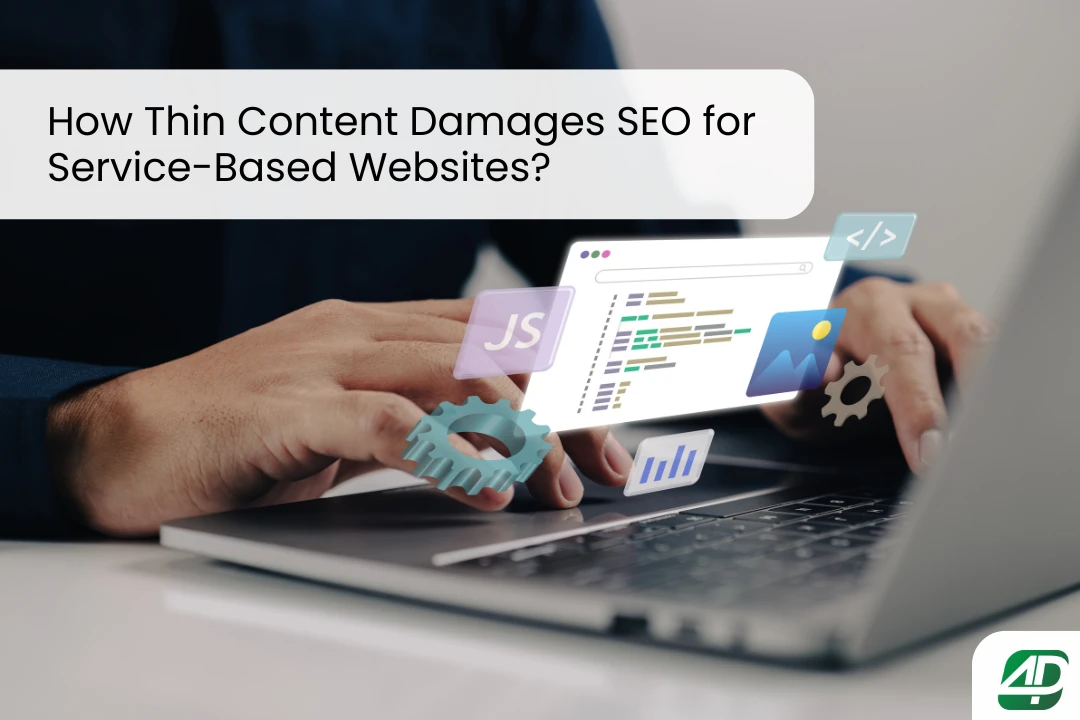Introduction
Have you ever landed on a web page that doesn't contain the information you are looking for and leaves you dissatisfied? Then that's thin content. Thin content in SEO refers to low-value pages. In simple terms, thin content is content that ranks higher on the Search Engine Result Pages (SERPs), but provides little to no value to the user who opens that page
For service-based businesses, having strong SEO is non-negotiable. However, if your content lacks depth, structure, or value, you're hurting your visibility without even realizing it. In this blog, let’s understand the effects of thin content on website ranking and what you can do to improve it.
Highlights:
How thin content hurts SEO for service-based businesses
Here are 5 major ways thin content damages your search performance:

1. High bounce rates :
When a user arrives at your website seeking information and encounters irrelevant content, the experience can be frustrating. Eventually, it leads visitors to exit your page. Google is very strict about this behaviour and tracks some metrics, such as bounce rate and time spent on a webpage, to assess user satisfaction.
If it detects that visitors are leaving, it interprets that your content fails to meet their needs. The consequence? A decline in your search engine rankings, as Google prioritizes sites that genuinely provide valuable content. This is one of the biggest Google ranking issues due to thin content.
2. Poor keyword relevance and context :
Simply inserting keywords into your content is not sufficient. If the accompanying text fails to provide meaningful and valuable information, Google will perceive your page as lacking depth. This can block your page from ranking for high-intent keywords in your niche.
This perception can hinder your page's ability to rank for high-intent keywords that are crucial within your niche. To succeed, it’s essential to create content that genuinely enhances the understanding of the topic and resonates with your audience's needs.
3. Weak authority signals :
Google uses content quality as a ranking signal. Thin content is created to redirect users to other pages or to promote affiliate products/services. Even if these thin pages rank on Google due to their high ranking, it's easy to see that these pages do not answer the query of visitors.
Thin content lacks authority, trust, and expertise, which are all crucial parts of the E-E-A-T framework (Experience, Expertise, Authoritativeness, Trust). In that case, the page loses authority and credibility. Resulting in getting less attention from Google.
4. Wasted crawl budget :
Google assigns a limited crawl budget to every website, which dictates how many pages it will crawl during a given timeframe. If the search engine spends valuable resources crawling low-quality or irrelevant pages, it can inadvertently overlook your most important content.
This inefficiency can have a significant impact on your site’s indexing and visibility, ultimately affecting your overall online presence.
5. Penalties from Google’s algorithm updates :
Once Google detects such thin content on a page, it either penalises or bans the page. The penalties can be severe, such as losing ranking. These penalties depend on the severity of the thin content. Hence, the below given SEO tips for service-based websites will help you to prioritize quality over quantity.
Each Google core update sharpens the focus on helpful content. So, thin content pages get affected the most. If your rankings dropped after a recent update, thin content might be the culprit.
How to fix thin content and improve rankings
Let’s move from the problem to the solution. Here’s how to fix thin content without burdening your entire site:
-
1. Boost your website with detailed content
When users visit your website, they expect answers to their queries. Hence, keeping your content detailed is crucial. Take an example of a service page.
-
What are the services?
-
Who is this service for?
-
What are the benefits?
-
FAQs and testimonials
To understand what your website is lacking, you'd better do a website content audit.
2. Interlink matters in your content
You can interlink the content with related services, blogs, and case studies. It helps Google understand your site is genuine and increases user engagement. It also helps your visitors to explore more by clicking on the link.
3. Keep updating your content
Share success stories, industry-specific results, or before-and-after comparisons to add authenticity. Write helpful blogs that answer common client questions. Do content optimization for service websites, update outdated info, add new sections, and enrich your content over time.
Once you apply the above given tips, your content will transform from thin to valuable, knowledge-giving webpages.
How The 4P Solutions can help you
At The 4P Solutions, we specialize in SEO for service-based websites. Our content and SEO team audits every word on your site to ensure it's built for ranking and converting by following SEO best practices.
We don’t just stuff keywords; we create intent-driven, optimized content that speaks to your audience and Google's algorithms. From content strategy to execution, we ensure your digital presence stands out in a crowded market. Connect with us at mktg@the4psolutions.com or call us at +91 85919 37177 to learn more.
Conclusion
Thin content may seem harmless, but for service-based businesses, it can quietly destroy your SEO. By investing in content that’s valuable, relevant, and optimized, you don’t just please Google; you build trust with your visitors. So don’t let your pages sit in the background of Google’s search list half-finished. Make every word count.Let The 4P Solutions, the B2B SEO agency, transform your content with a content marketing strategy from thin to authoritative and start ranking where it matters.
FAQs
Google favors pages that offer depth, context, and relevance.
Create dedicated, detailed pages for each service to improve website ranking and user clarity.
At least every 6–12 months. Add new insights, update stats, and refresh the copy.
Look for high bounce rates, low time on page, and declining keyword rankings; these are signs that your content is affected.

